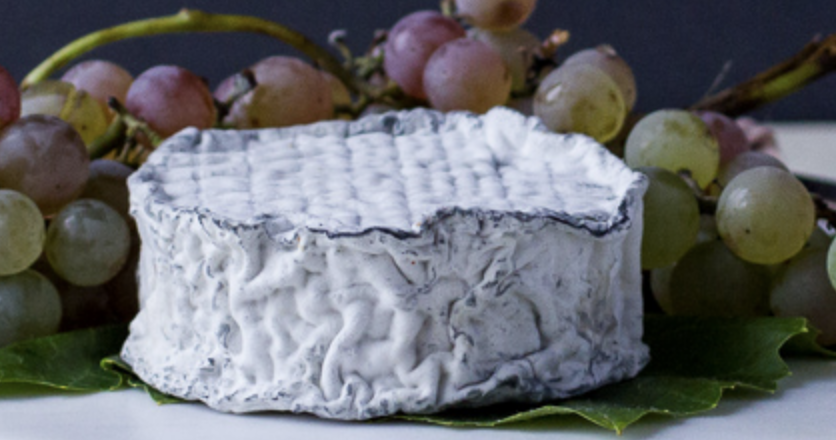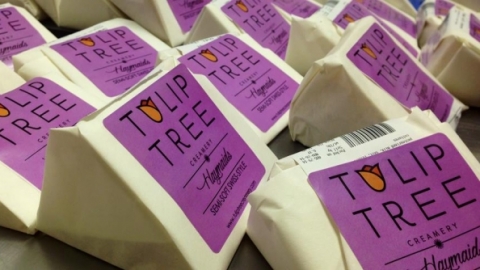Celebrate National Cheese Day with an Indiana Favorite
Cheese. If there’s one food in the entire world everyone loves, it’s cheese. Of course, it's also one of the most diverse foods and what one person likes, another may not. And while many, especially here in the states, tend to reach first for what they’re familiar with—mozzarella, parmesan, cheddar—there are many, many different types of cheeses worth trying.
So in honor of National Cheese Day, we’d like to introduce you to one of our favorite Hoosier cheesemakers, Judy Schad, and her family’s farm in southern Indiana, Capriole Goat Cheese. But first, before we dig into the wonderful world of goat cheese, here’s a short read on what cheese is, and what cheese isn’t.
Cheese 101
Cheese is made from animal’s milk, usually cow, goat or sheep. Yes, there are vegan “cheeses” on the market made from plant milk (seeds, nuts, etc.) but many cheese enthusiasts and dairy farmers alike are pushing to keep non-dairy “cheese” (and other items) from carrying traditional dairy terms. Earlier this year, the Dairy Pride Act was introduced to Congress asking for all “non-dairy products made from nuts, seeds, plants and algae no longer be mislabeled with dairy terms such as milk, yogurt or cheese.” The FDA defines dairy products as those coming from dairy animals, but labeling regulations have never been enforced. Proponents of the bill say mislabeling plant-based products as “milk,” “cheese,” and “yogurt,” may lead consumers to believe the nutritional content is the same as if they were made from an animal’s milk. The bill does have support in both the House and Senate but whether or not is passes, is yet to be seen. Either way, one thing's for sure … worldwide there are are more types of cheese—dairy-based and plant-based—than one can count, which is a good thing because we all love it so much.
Cheese falls into two main categories—ripened and unripened. Common unripened cheese include cottage cheese, ricotta and cream cheese. As for ripened cheese, there are three groups:
Soft: Those that are, yea, soft and ripened for a short period such as brie, feta and my personal favorite, Camembert
Hard: Those that are, you guessed it, hard. Hard and semi-hard cheeses are ripened for a longer time and are usually easy to grate; Parmesan, cheddar, gouda, Swiss.
Blue: Although it might sound unappealing, the ripening of cheese in green mold makes some of the most luxurious cheeses in the world. A few types of blue cheese are roquefort, gorgonzola and the exclusive stilton.
As for Capriole’s goat cheeses, there are a plethora of options—some aged, some fresh, but all just as delicious as the next. Read on to learn more.
Edible Indy: About goat cheese, how does the flavor compare to the traditional cow’s milk cheeses most Americans are familiar with?
Judy Schad: Goat cheese has incomparable texture because the fat composition is so much finer than that of cow milk. But, just as you can’t compare a cow-milk gouda with a cow-milk feta or cottage cheese, you can’t compare the flavor of a fresh or fresh-ripened goat cheese with an aged one.
EI: What about the process … how long does it take to make?
JS: Fresh cheeses are made in a three-day process that can extend for another seven days if they are also mold-ripened. These are all carefully ladled by hand from a 400 gallon cheese vat. The aged cheeses are made in one day but age for four to eight months depending on the size of the cheese.
EI: What are some of the different ingredients used to create the variety of flavors?
JS: The ingredients are the basically the same for making goat-milk cheese as making cow-milk cheese; milk, culture, rennet—the magic that makes them different is in the process.
EI: What do you recommend someone try if they've never had goat cheese before?
JS: Old Kentucky or Julianna because both texture and flavor are the most similar to the style of cheeses (but better) that we all grew up with—unless we lived in France.
EI: Do you have a favorite?
JS: Piper’s Pyramide because it’s perfect!
EI: Where can people find your products?
JS: Goose the Market, Wildwood Market and Whole Foods.
As for pairings, one of Judy’s favorite ways to enjoy their cheeses is to pair them with bourbon. Here are some descriptions of Capriole goat cheeses and a few of Judy’s paired suggestions to enhance your tasting experience.
Sofia: acidic and bright, with some earthy, complex goat notes at the end. Pair with Michter’s American, a smooth drink with spicy and sweet elements enhanced by the acidity and light texture of the cheese.
Piper’s Pyramide: same brightness and acidic notes as Sofia without as much goat overtone. Very
subtle spice edge from the smoked paprika. Pair with Michter’s American—a whiskey forward pairing, the cheese acidity pushes the richness and sugar of the whiskey by contrast.
Julianna: fine-textured and silky aged cheese with smooth, moist paste, and an herbal-floral rind. Pair with
Michter’s Sour Mash: Some wild, hay-like flavors … the cheese and the acidity and sour notes are well-matched and balanced.
Old Kentucky Tomme: same smooth, soft paste as Julianna with some mushroomy and pineapple overtones. Pair with Michter’s Straight Rye to bring fruity flavors forward in both cheese and drink.
Mont St. Francis: smooth, soft paste, with funky, smoky overtones. Pair with Michter’s Toasted Barrel Rye. The dark sugar and smoky edge of the rye enhance the sorghum and smokiness of the cheese.
O’Banon: Acidic, slightly tannic and very smooth delicate paste. Pair with Michter’s 10-year Bourbon to bring out the brightness and sweetness of the bourbon without clashing.









